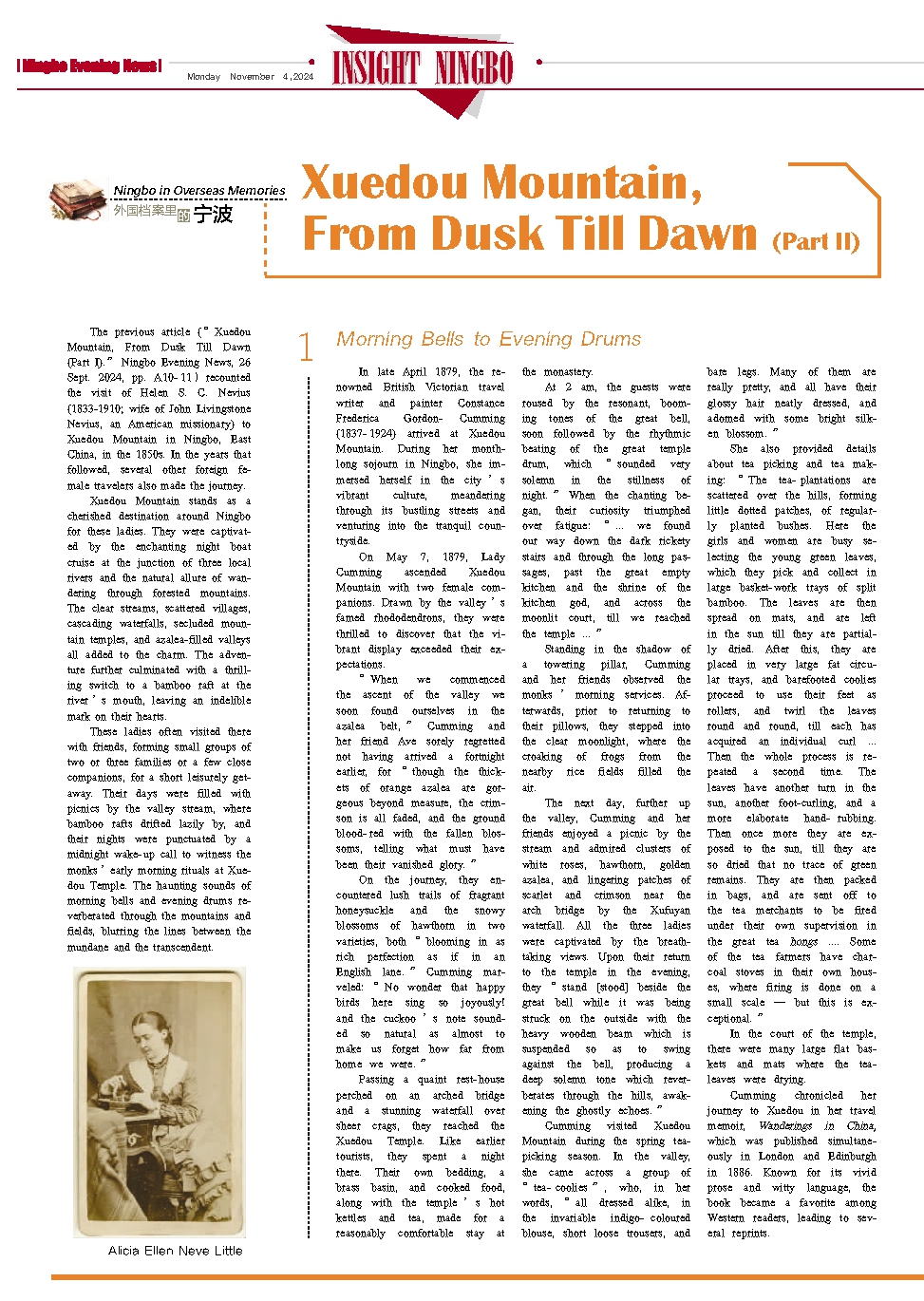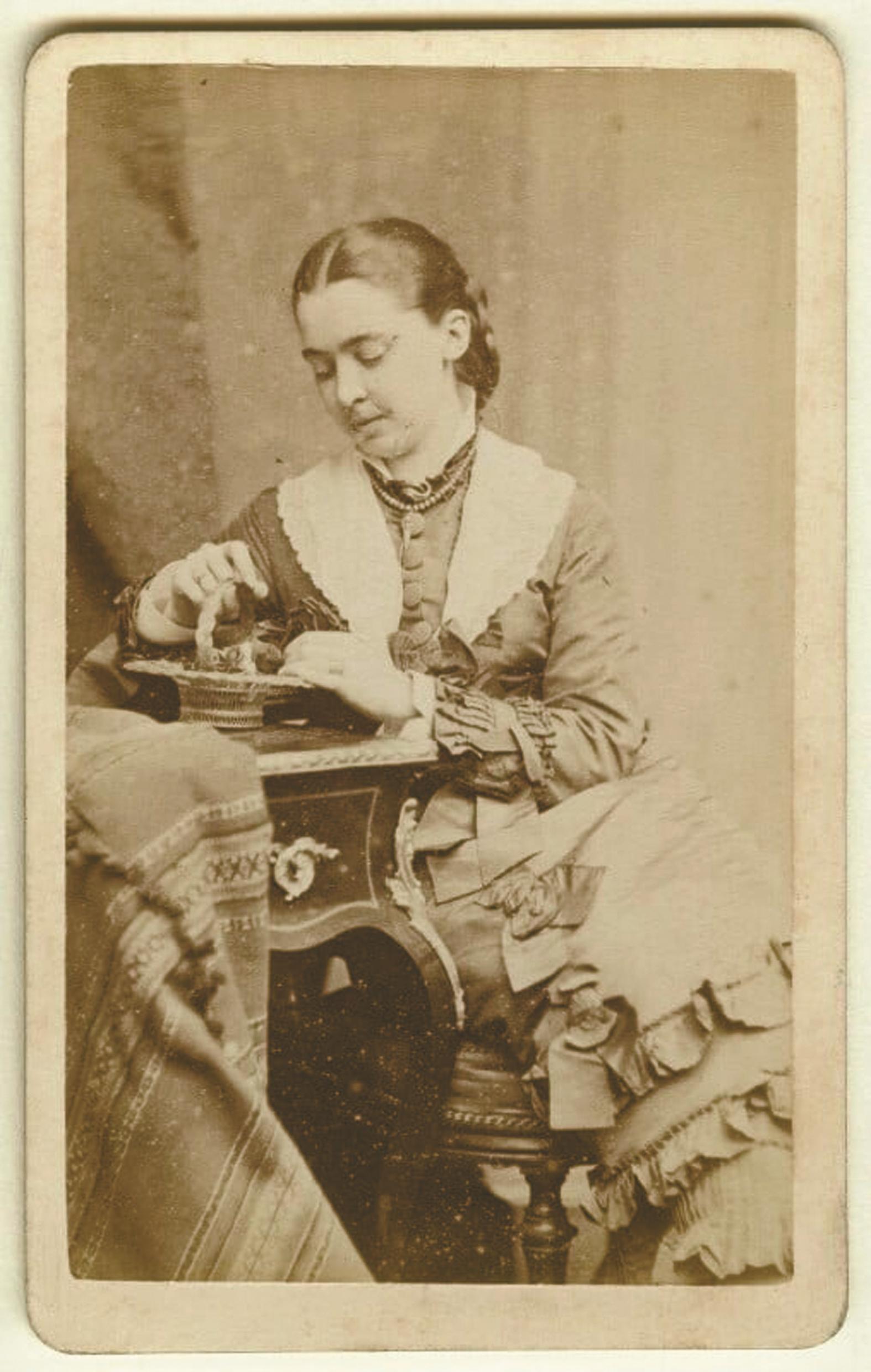The previous article (“Xuedou Mountain, From Dusk Till Dawn (Part I).” Ningbo Evening News, 26 Sept. 2024, pp. A10-11)recounted the visit of Helen S. C. Nevius (1833-1910; wife of John Livingstone Nevius, an American missionary) to Xuedou Mountain in Ningbo, East China, in the 1850s. In the years that followed, several other foreign female travelers also made the journey.
Xuedou Mountain stands as a cherished destination around Ningbo for these ladies. They were captivated by the enchanting night boat cruise at the junction of three local rivers and the natural allure of wandering through forested mountains. The clear streams, scattered villages, cascading waterfalls, secluded mountain temples, and azalea-filled valleys all added to the charm. The adventure further culminated with a thrilling switch to a bamboo raft at the river’s mouth, leaving an indelible mark on their hearts.
These ladies often visited there with friends, forming small groups of two or three families or a few close companions, for a short leisurely getaway. Their days were filled with picnics by the valley stream, where bamboo rafts drifted lazily by, and their nights were punctuated by a midnight wake-up call to witness the monks’ early morning rituals at Xuedou Temple. The haunting sounds of morning bells and evening drums reverberated through the mountains and fields, blurring the lines between the mundane and the transcendent.
Morning Bells to Evening Drums
In late April 1879, the renowned British Victorian travel writer and painter Constance Frederica Gordon-Cumming (1837-1924) arrived at Xuedou Mountain. During her month-long sojourn in Ningbo, she immersed herself in the city’s vibrant culture, meandering through its bustling streets and venturing into the tranquil countryside.
On May 7, 1879, Lady Cumming ascended Xuedou Mountain with two female companions. Drawn by the valley’s famed rhododendrons, they were thrilled to discover that the vibrant display exceeded their expectations.
“When we commenced the ascent of the valley we soon found ourselves in the azalea belt,” Cumming and her friend Ave sorely regretted not having arrived a fortnight earlier, for “though the thickets of orange azalea are gorgeous beyond measure, the crimson is all faded, and the ground blood-red with the fallen blossoms, telling what must have been their vanished glory.”
On the journey, they encountered lush trails of fragrant honeysuckle and the snowy blossoms of hawthorn in two varieties, both “blooming in as rich perfection as if in an English lane.” Cumming marveled: “No wonder that happy birds here sing so joyously! and the cuckoo’s note sounded so natural as almost to make us forget how far from home we were.”
Passing a quaint rest-house perched on an arched bridge and a stunning waterfall over sheer crags, they reached the Xuedou Temple. Like earlier tourists, they spent a night there. Their own bedding, a brass basin, and cooked food, along with the temple’s hot kettles and tea, made for a reasonably comfortable stay at the monastery.
At 2 am, the guests were roused by the resonant, booming tones of the great bell, soon followed by the rhythmic beating of the great temple drum, which “sounded very solemn in the stillness of night.” When the chanting began, their curiosity triumphed over fatigue: “... we found our way down the dark rickety stairs and through the long passages, past the great empty kitchen and the shrine of the kitchen god, and across the moonlit court, till we reached the temple ...”
Standing in the shadow of a towering pillar, Cumming and her friends observed the monks’ morning services. Afterwards, prior to returning to their pillows, they stepped into the clear moonlight, where the croaking of frogs from the nearby rice fields filled the air.
The next day, further up the valley, Cumming and her friends enjoyed a picnic by the stream and admired clusters of white roses, hawthorn, golden azalea, and lingering patches of scarlet and crimson near the arch bridge by the Xufuyan waterfall. All the three ladies were captivated by the breathtaking views. Upon their return to the temple in the evening, they “stand [stood] beside the great bell while it was being struck on the outside with the heavy wooden beam which is suspended so as to swing against the bell, producing a deep solemn tone which reverberates through the hills, awakening the ghostly echoes.”
Cumming visited Xuedou Mountain during the spring tea-picking season. In the valley, she came across a group of “tea-coolies”, who, in her words, “all dressed alike, in the invariable indigo-coloured blouse, short loose trousers, and bare legs. Many of them are really pretty, and all have their glossy hair neatly dressed, and adorned with some bright silken blossom.”
She also provided details about tea picking and tea making: “The tea-plantations are scattered over the hills, forming little dotted patches, of regularly planted bushes. Here the girls and women are busy selecting the young green leaves, which they pick and collect in large basket-work trays of split bamboo. The leaves are then spread on mats, and are left in the sun till they are partially dried. After this, they are placed in very large fat circular trays, and barefooted coolies proceed to use their feet as rollers, and twirl the leaves round and round, till each has acquired an individual curl ... Then the whole process is repeated a second time. The leaves have another turn in the sun, another foot-curling, and a more elaborate hand-rubbing. Then once more they are exposed to the sun, till they are so dried that no trace of green remains. They are then packed in bags, and are sent off to the tea merchants to be fired under their own supervision in the great tea hongs .... Some of the tea farmers have charcoal stoves in their own houses, where firing is done on a small scale — but this is exceptional.”
In the court of the temple, there were many large flat baskets and mats where the tea-leaves were drying.
Cumming chronicled her journey to Xuedou in her travel memoir, Wanderings in China, which was published simultaneously in London and Edinburgh in 1886. Known for its vivid prose and witty language, the book became a favorite among Western readers, leading to several reprints.



